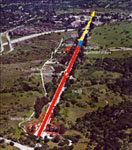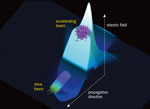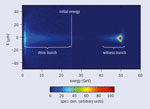FACET shows the way in accelerator research
By addressing key questions for a plasma wakefield accelerator, the Facility for Accelerator Science and Experimental Tests (FACET) at SLAC will help a scientific concept with extraordinary potential to become the accelerator technology of the 21st century.
In their quest to learn more about the fundamental nature of matter, high-energy physicists have developed particle accelerators to reach ever higher energies to allow them to "see" how matter behaved in
 |
| Fig.1 |
In the past decade, the plasma wakefield accelerator (PWFA) has emerged as one such promising approach, thanks to the spectacular experimental progress at the Final Focus Test Beam (FFTB) facility at the SLAC National Accelerator Laboratory. Experiments there have shown that plasma waves or wakes generated by high-energy particle beams can accelerate and focus both high-energy electrons and positrons. Accelerating wakefields in excess of 50 GeV/m – roughly 3000 times the gradient in the SLAC linac – have been sustained in a metre-scale PWFA to give, for the first time using an advanced acceleration scheme, electron energy gains of interest to high-energy physicists.
To develop the potential of the PWFA and other exploratory advanced concepts for particle acceleration further, the US Department of Energy recently approved the construction of a new high-energy beam facility at SLAC: the Facility for Accelerator Science and Experimental Tests (FACET). It will provide electron and positron beams of high energy density, which are particularly well suited for next-generation experiments on the PWFA (Hogan et al. 2010).
 |
| Fig. 2 |
The construction phase of the FACET project started in July 2010 and should finish in April this year. Beam commissioning will follow and the first experiments are expected to begin in the summer. A recently completed shielding wall at the end of Sector 20 allows simultaneous operation of FACET and the LCLS.
The FACET beam will offer new scientific opportunities not only in plasma wakefield acceleration but also in dielectric wakefield acceleration, investigation of material properties under extreme conditions and novel radiation sources. To get a head start on the research opportunities, university researchers and SLAC physicists met at SLAC in March 2010 for the first FACET Users Workshop. This was the first opportunity for SLAC to unveil details about FACET’s capabilities and for the visiting scientists to outline their research needs. Beam time will be allocated using an annual, peer-reviewed proposal process.
The plasma wakefield technique
In the PWFA a short but dense bunch of highly relativistic charged particles produces a space-charge density wave or a wake as it propagates through a plasma. As figure 2 shows, the head of the single bunch ionizes a column of gas – lithium vapour – to create the electrically neutral plasma and then expels the plasma electrons to set up the wakefield. As the plasma electrons rush outward, they create a longitudinally decelerating electric field that extracts energy from the head of the bunch. The plasma ions that are left behind create a restoring force that draws the plasma electrons back to the beam axis. When the electrons rush inwards, they create a longitudinally accelerating field in the back half of the wake, which returns energy to the particles in the back of the same bunch or alternately to a distinct second accelerating bunch. The plasma thus acts as an energy transformer.
The FFTB plasma wakefield experiments used a single 20 kA electron drive bunch to excite 50 GeV/m wakes in plasma of density 2.7 × 1017 e–/cm3. Energy was transferred from the particles in the front of
 |
| Fig.3 |
Plasma wakefield acceleration will be a major area of research at FACET. Simply put, this research will strive to answer most of the outstanding physics issues for high-gradient plasma acceleration of both electrons and positrons, so that the potential for a PWFA as a technology for a future collider can be realistically assessed. The main goal of these future experiments is to demonstrate that plasma wakefield acceleration can not only provide an energy gain of giga-electron-volts for electron and positron bunches in a single, compact plasma stage, but can also accelerate a significant charge while preserving the emittance and energy spread of the beam.
The plasma wakefield experiments on FACET will need two distinct bunches, each about 100 fs long separated by about 300 fs. The first contains about 10 kA of peak current both to produce a uniform, metre-long column of plasma and then to drive the wake. The second bunch, which extracts energy from the wake, has a variable peak current. The sub-100 fs bunches needed for plasma wakefield acceleration are generated at FACET through a three-stage compression process that continually manipulates the longitudinal phase space so as to exchange correlated energy spread for bunch length, in a process called "chirped pulse compression". There will be an additional collimation system within the final compression stage at FACET and the collimation in the transverse plane will result in structures in the temporal distribution of the final compressed bunch(es).
In this way FACET will produce two co-propagating bunches. By adjusting the charge and duration of the witness bunch, FACET will be able to pass from the regime of negligible beam-loading that has been studied so far to beam acceleration with strong wake-loading. By loading down or flattening the accelerating wakefield, FACET will accelerate the witness bunch with a narrow, well defined, energy spread as the simulation in figure 3 shows.
Key beam properties
High-energy physics applications require not only high energies but also high beam power to deliver sufficient luminosity. For a linear collider with an energy of tera-electron-volts in the centre-of-mass this translates to nearly 20 MW of beam power for a luminosity of 1034 cm–2s–1. When combined with the efficiencies of other subsystems (wall-plug to klystron to drive beam), maximizing the efficiency of the plasma interaction will be a crucial element in keeping down the overall costs of the facility. For example, a recent conceptual design for a PWFA-based linear collider (PWFA-LC) used a drive-beam-to-witness-beam coupling of 60% to achieve an overall efficiency of 15% (Seryi et al. 2009). Theoretical models and computer simulations have estimated the efficiency of the plasma interaction to be on the order of 60% for Gaussian beams and approaching 90% for specifically tailored current profiles (Tzoufras et al. 2008).
Improving accelerator performance using spatially and temporally shaped pulses is one of the forefronts of research in beam physics that can be explored at FACET. Tailoring the current profile of the drive beam allows the plasma to extract energy at a uniform rate along the bunch so as to maximize the overall efficiency. Figure 4 shows an example of such a tailored current profile for FACET and the accompanying simulated plasma wake. Bunch shaping has the added benefit of increasing the transformer ratio – that is, the ratio of the peak accelerating field divided by the peak decelerating field. A larger transformer ratio will lead to more energy gain per plasma stage. Finally, tailoring the profile of the witness beam loads the accelerating wakefield to produce the desired narrow energy spread.
 |
| Fig.4. |
Positron acceleration
Although plasma wakefield acceleration may find applications in areas other than high-energy physics, such as compact X-FELs, collider applications will require plasmas to accelerate not only electrons, but also positrons. Studies have already shown that relatively long positron bunches can create wakefields analogous to the electron case, which can be used to accelerate particles over distances of a metre or so with energy gains approaching 100 MeV (Blue et al. 2003). The response of the plasma to the incoming positron beam is different than for an electron beam. In the positron case, the plasma electrons are drawn in towards the beam core. This leads to fields that vary nonlinearly in radius and position along the bunch, resulting in halo formation and emittance growth (Hogan et al. 2003 and Muggli et al. 2008). FACET will be the first facility in the world to deliver compressed positron bunches suitable for studying positron acceleration with gradients of giga-electron-volts per metre in high-density plasmas.
Recent studies have shown that there may be an advantage in accelerating positrons in the correct phase of the periodic wakes produced by an electron drive beam. A simple yet elegant study of this
| |
| Fig.5. |
Source: CERN COURIER Website